Regional News
Bombings in Thailand Draw Attention to Forgotten War in South

Tourists walk the scene of a bomb blast in the resort city of Hua Hin, Thailand, on Aug. 12, 2016. (EPA)
.
HUA HIN – It happens with horrifying frequency in southern Thailand, a country much of the world associates with pristine beaches and alluring, sapphire blue seas: a bomb goes off. Victims are maimed or killed. Security forces comb through blood-spattered wreckage and debris.
On Thursday and Friday, 11 more bombs rattled seven Thai provinces, killing four people and wounding dozens more. But this time was different: the targets were not in the country’s three southernmost provinces, where a bitter war waged by Muslim separatists has flared for more than a decade.
Instead, they shook towns filled with tourists further north, places like Hua Hin, where 11 foreigners were injured, most by a small explosive device that detonated in a narrow alley filled with bars, restaurants and massage parlors.
Ethnic Malay insurgents launched their armed bid for greater autonomy in Thailand’s so-called “deep south” in 2004. But more than 6,700 dead and 12,000 wounded later, the struggle seems more forgotten than ever – a reality illustrated by a flood of weekend media coverage that dwarfed the usual trickle of reporting about the far-southern conflict.
“Sadly, people get used to violence. The media gets bored with it. The story becomes mundane,” said Rungrawee Chalermsripinyorat, an independent analyst and expert on the insurgency.
If it turns out insurgents were responsible for last week’s bombings, it would mark a dangerous new expansion of the low-level war that has plagued the mostly Buddhist country’s southern border region with Malaysia.
It could also prove a dangerous incentive to carry out more violence.
With few exceptions, the militants have so far avoided attacking known tourist destinations because “they didn’t want to be seen as a terrorist group,” Rungrawee said. “But that could change if attacks like this prove effective” by attracting greater attention to a war that’s ground on largely out of sight for years, he said.
While there has been no claim of responsibility and authorities have yet to blame any specific group, police investigators and analysts say the latest violence bears striking similarities to the methods used by the separatist militants who have traditionally limited operations to the Muslim-dominated provinces of Yala, Pattani and Narathiwat.
The attacks Thursday and Friday took place in seven locations south of Bangkok, including the island of Phuket. The bombs were small and appeared designed to shock rather than induce mass casualties, and left no immediate major impact on Thailand’s lucrative tourist industry.
Asked Monday about the possibility that insurgents orchestrated the latest violence, police commissioner Chakthip Chaijinda reiterated words spoken by other top officials over the weekend, saying “there are similarities in bomb-making methods and the equipment.”
Authorities say some of the homemade bombs were triggered remotely by cellphones – a tactic used by insurgents. Some of the phones, recovered by police, were reportedly purchased in Malaysia, into which Thai militants are known to cross with ease.
Malaysian police chief Khalif Abu Bakar confirmed Thai authorities have reached out, and officials on his side of the border were searching for those who purchased and sold the phones.
The war in the south flared 12 years ago after security forces shot dead seven Thai Muslims during an anti-government protest in Tak Bai in Narathiwat province, and hauled away 78 others packed so tightly they died of asphyxiation.
Muslims in the south say they don’t feel like full members of Thailand’s majority Buddhist society and complain of discrimination, rights abuses and arbitrary detention. The provinces in the south once belonged to a Malay sultanate which Thailand annexed in 1902.
The insurgents are split into several factions, the strongest of which is the Patani-Malay National Revolutionary Front, or BRN. The groups’ leadership, organizational structure and membership are secretive, so much so that Rungrawee said some recruits who have taken part in attacks were not even aware of which faction they belonged to.
The government of former Prime Minister Yingluck Shinawatra began peace talks with separatists in 2013, although there was some doubt about whether the leaders attending fully represented insurgents on the ground. Yingluck’s government was toppled in a coup a year later, and the junta that rules Thailand has continued the effort.
Talks, however, have gotten bogged down in such basic parameters as identifying the insurgents. Thailand’s government insists on referring to them simply as “people with different opinions from the state,” a position the militants reject.
John Blaxland, a senior fellow at Australian National University, said he believed militants could have launched last week’s bombings to increase their bargaining power at the negotiating table.
“If my theory is correct, the message is: ‘We want you to make more concessions in the south of Thailand,'” Blaxland said. “They figure that the message is better heard through actions.”
Pongphisoot Busbarat, a lecturer at Columbia University’s School of International and Public Affairs, said if the militants were responsible for the bombings, they could be trying “to show that the hawkish approach adopted by the military is not acceptable.”
Thailand’s military junta has shown little tolerance for dissent since it overthrew a democratically elected government two years ago. Critical opinions are suppressed and critics are regularly whisked away to army bases for questioning.
On Aug. 7, the government held a successful referendum on a new constitution that will cement the military’s powerful hand in politics for years to come.
In the week leading to the vote, insurgents registered their clear opposition to the charter by spray-painting the words “Referendum X” and “Constitution X” onto roads, street signs and schools across the south. Significantly, they did so in Thai, rather than the Malay script commonly used in the south.
They also carried out more than 50 bombings during the first week of August alone.
All were in the south; few made headlines.
On Monday morning, two motorcycle-riding soldiers were wounded in Narathiwat by another roadside bomb, police said. Explosive experts who arrived at the scene detonated a second bomb they believe was intended for those who rushed to the injured troops’ aid.
—
Associated Press journalists Natnicha Chuwiruch and Vicky Ge Huang contributed to this report.

Regional News
Thai Immigration Police Detain Over 26,000 Illegal Migrant Workers
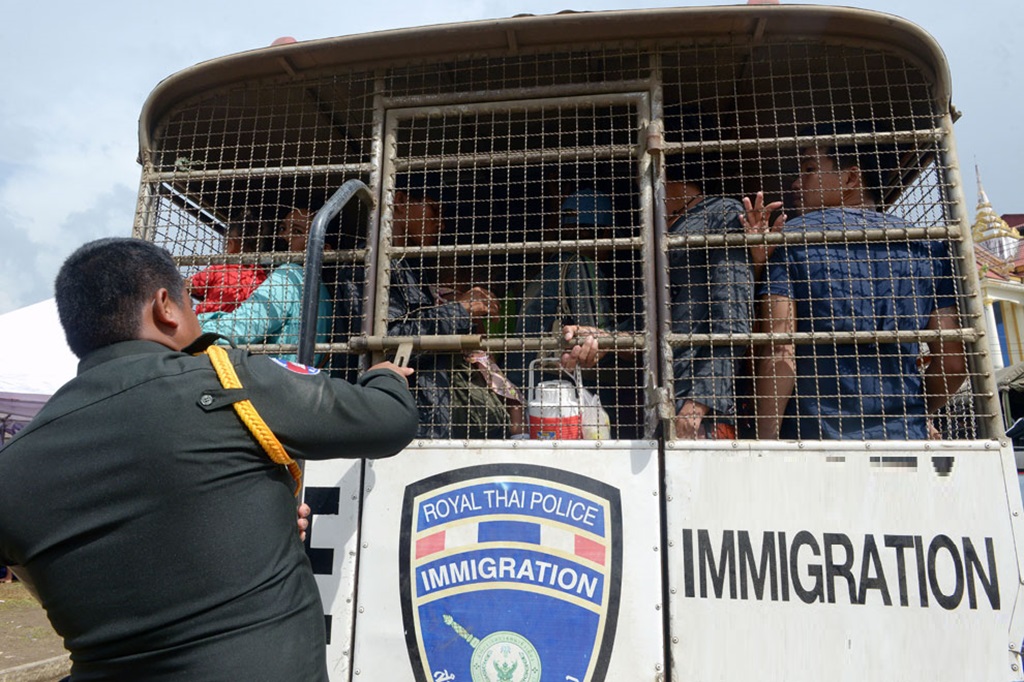
Thailand’s Immigration Police have detained approximately 26,000 illegal migrant workers from Laos, Myanmar, and Cambodia during an eight-day operation in Bangkok and surrounding regions, according to a Royal Thai Police spokesperson.
Mr Adisorn Keudmeuangkhon of the Bangkok-based Migrant Working Group said the drive was in response to an increasing number of concerns about an influx of illegal migrant labor.
“Some Thai people see that many illegal workers are competing for their job positions in the past few months,” he told me. “That’s why the ministry has to take tougher action.”
Civil strife in Myanmar and the recent implementation of a military conscription have driven thousands of Burmese into Thailand, while severe inflation and limited job opportunities in Laos have also encouraged an influx of workers from that country.
Between June 5 and 12, officials detained and checked 20,111 Myanmar laborers, 1,659 Laotian migrant workers, and 3,971 Cambodian workers, according to the Ministry of Labor.
It marked the start of a 120-day campaign to audit workplaces and arrest unlawful migrant workers, according to the government.
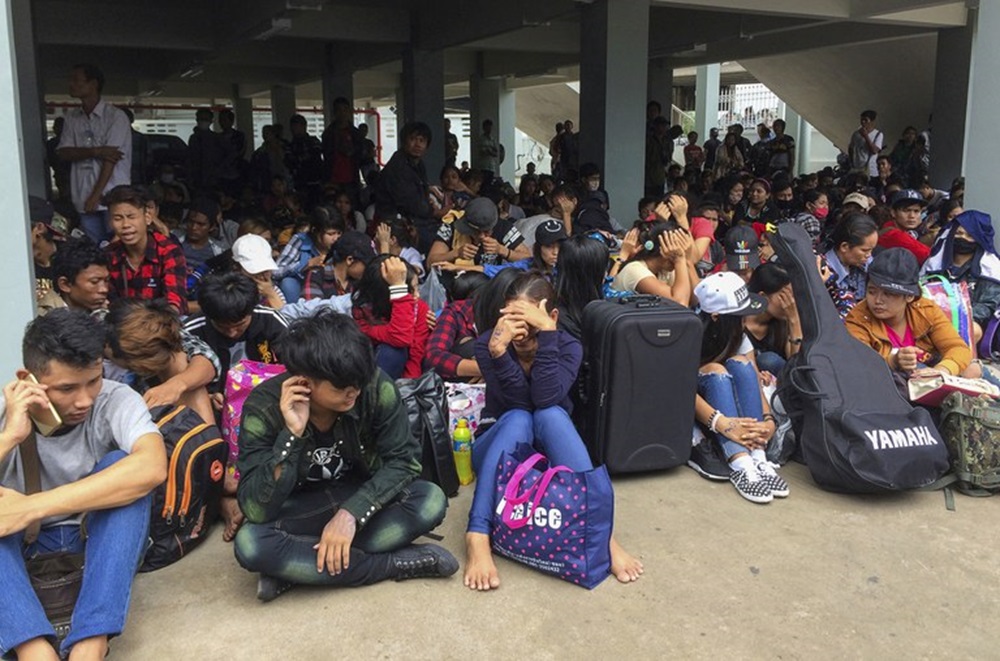
Migrant Workers to be Deported
According to Keudmeuangkhon, undocumented workers face fines ranging from 5,000 to 50,000 Thai baht (US $136 to $1,365), deportation, and a two-year prohibition on re-entering Thailand.
Authorities did not intend to file criminal charges, he claimed.
Authorities raided 1,774 workplaces, according to Moe Gyo, chairman of the Joint Action Committee on Burmese Affairs, which advocates for Myanmar labor rights.
He stated that since the military junta activated conscription, there has been an upsurge in the number of arrests of Myanmar citizens in Thailand who do not have a work permit identity card.
All men aged 18 to 35 and women aged 18 to 27 must serve in the military for at least two years. The first group of 5,000 conscripts summoned by Myanmar’s junta will start duty at the end of this month, military sources told AFP on Monday.
According to Keudmeuangkhon, the bulk of Lao migrant workers in Thailand work as fresh market shopkeepers, restaurant servers, and mall salespeople.
Most people visit Thailand as part of ASEAN’s visa-free policy for tourists, but they stay longer than the 30-day restriction once they find job.
“Employers like to hire Lao migrant workers in the service sector because they can speak fluent Thai,” he told me.
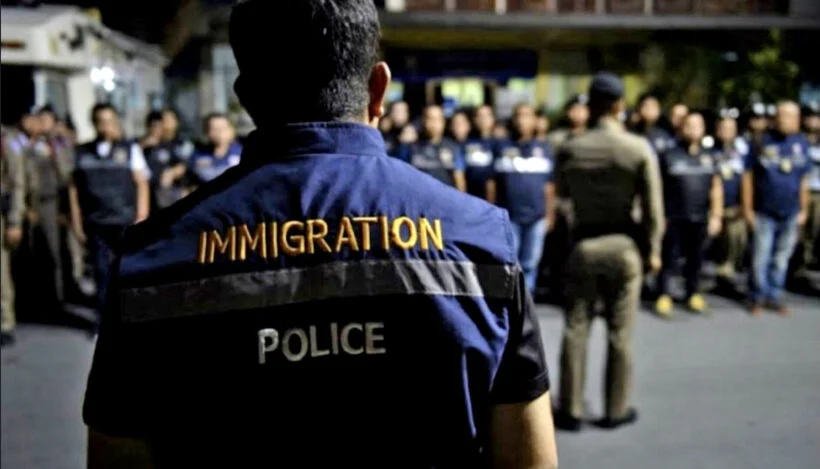
Immigration Police Detain Illegal Migrant Workers
The Thai Cabinet may approve an enhanced program for Thai employers to register their unauthorized foreign workers in July or August. Keudmeuangkhon explained.
Last month, the Thai Ministry of Labor’s Foreign Workers Administration office announced that 268,465 Lao migrant workers were officially working in Thailand.
Baykham Kattiya, Lao Minister of Labor, told Radio Free Asia earlier this month that there are 415,956 migrant workers in other nations, the majority of whom work in Thailand.
According to her, the Lao government believes that over 203,000 persons working outside of the nation lack proper work documents.
However, a Lao official familiar with the labor industry informed Radio Free Asia, a BenarNews-affiliated news station, on June 20 that the number of illegal Lao migrant workers in Thailand and abroad is likely significantly greater.
“They go to other countries as illegal migrant workers through different types of methods – as tourists or students,” said the politician. “Thus, it is hard for the immigration police to collect data on these people.”
Government Officials Responsible for Smuggling in Migrant Workers
Government Officials Responsible for Smuggling in Migrant Workers
News
High School Student Dies After Being Electrocuted By School Water Dispenser
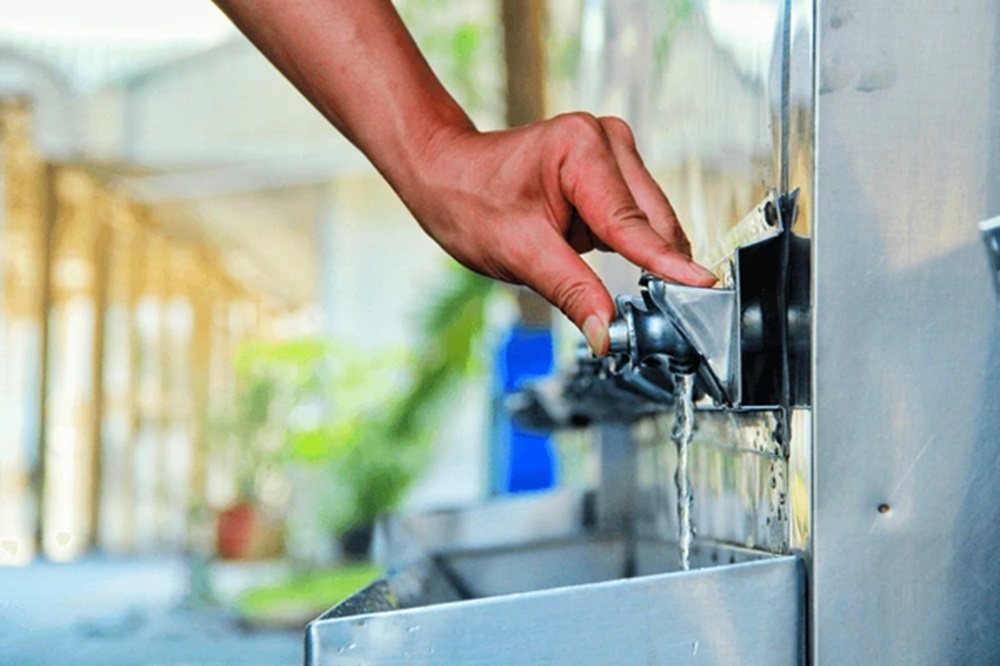
Thailand’s Office of Basic Education Commission has initiated an investigation into the electrocution of a 14-year-old student by a water dispenser in a high school. The event happened at noon on Friday, during the high school’s sports day. The victim was a Grade 8 student.
According to local media in Trang Province, the incident occurred when a teacher instructed the pupil to turn off a water dispenser amid a heavy rain.
According to a witness, the child collapsed while strolling with his friend near a water station. The friend claimed he attempted to assist but was also shocked by electricity.
According to reports, the friend then recovered, left the site, and requested assistance from teachers. A teacher ran to the scene and used a towel to pull the boy away by the ankle. He was taken to the hospital, but it was too late, they claimed.
The event sparked criticism from parents and netizens over school safety, as well as the slow response to aid the young youngster.
Mr. Chainarong Changrua, head of Trang-Krabi’s Secondary Educational Service Area Office, told local media on Sunday that forensic officers from Trang Provincial Police had visited the area. They discovered the blown breaker switch behind the water dispenser, he explained.
The breaker was burned out, thus the authorities assumed the disaster was caused by a short circuit that allowed energy to spill to a neighboring power pole. The student also appeared wet and was not wearing shoes when electrocuted.
According to the Office of Basic Education Commission, a probe team will complete its investigation this week.
The student’s father, Mr Pornchai Thepsuwan, 53, claimed he was saddened when he saw his son’s body. The boy (Wayu), was the youngest of two boys, he explained. He stated that following the tragedy, the school director and staff gave financial assistance to the families.
Mr Pornchai also said he would not seek charges against the institution because he believed it was an accident.
Electrical accidents in Thailand
Electrocution instances in Thailand have increased alarmingly in recent years. Many mishaps occur as a result of improper wiring and inadequate maintenance of electrical systems.
Public locations, such as schools and markets, frequently lack adequate safety precautions, putting individuals in danger. In rural areas, antiquated infrastructure exacerbates the situation, resulting in more frequent and serious events.
Although several high-profile cases have brought these challenges to light, genuine progress has been gradual. Furthermore, the rainy season heightens the likelihood of electrical accidents, as water and exposed wires do not mix well.
The government has made steps to strengthen safety standards, but enforcement is patchy. More education on electrical safety could help to reduce these accidents.
Unfortunately, better infrastructure and tougher rules may have prevented many of these incidents. The loss and injuries caused by electrocution are avoidable, emphasizing the need for immediate action.
Over 200 High School Students Facing Sedition Charges in Thailand
Over 200 High School Students Facing Sedition Charges in Thailand
News
Thailand’s Tourist Police Crackdown on Tourist Scammers in Pattaya
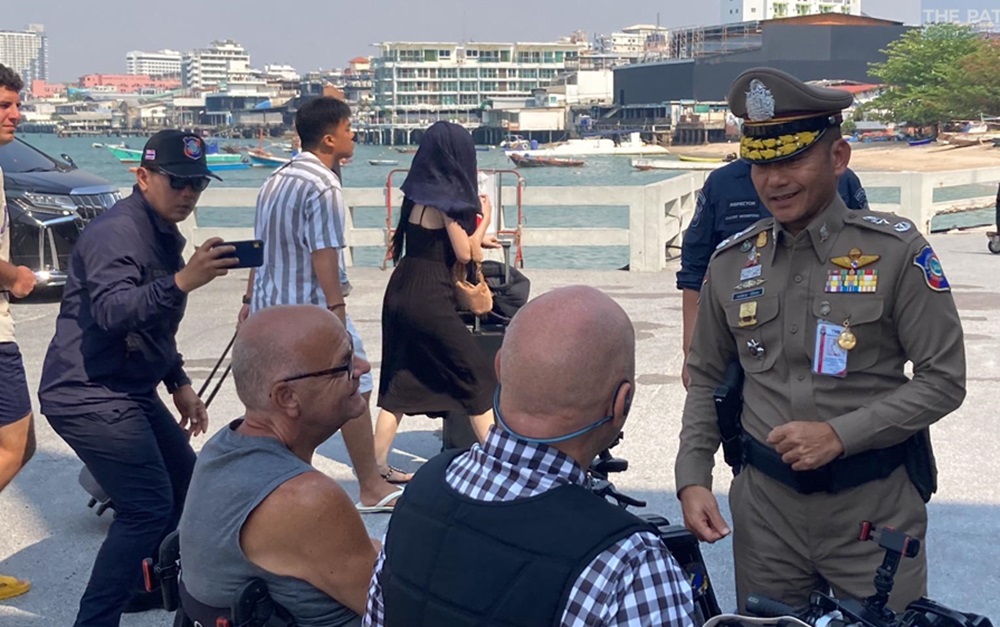
Thailand’s Tourist Police said it is collaborating with embassies from five countries to combat tourist scams and ten criminal gangs in Pattaya. The Tourist Police Bureau, convened a meeting on Thursday Pol Lt Gen Saksira Phuek-am told a press briefing.
Pol Lt Gen Saksira Phuek-am, the Tourist Police bureau commissioner said the participants included ambassadors from South Korea, Ukraine, Russia, India, and Switzerland.
He told the briefing the he had ordered a crackdown on tourist frauds, such as fraudulent or low-quality tour operators and unfair sales of goods and services. Stepped-up operations began on June 19 and will continue until June 25.
He stated that the agency was working with numerous organisations to increase tourists’ confidence in visiting Pattaya.
Gen Saksira spent time on the famed Walking Street speaking with officers on duty and assigned them to seek for members of ten criminal groups known to operate in Pattaya.
Meanwhile, Prime Minister Srettha Thavisin will visit Chon Buri on Saturday to assess the tourism situation. He intends to visit the site of a future Formula One racecourse near Khao Phra Tamnak in Bang Lamung District.
Prime Minister Srettha recently met with Formula One organisers in Italy to examine the potential of including Thailand on the race schedule in the future.
On Sunday, the Prime Minister will pay a visit to Rayong’s U-tapao airport to discuss development on the airport’s land, with the goal of encouraging investment in the Eastern Economic Corridor.
Police Chief Reinstated
In other police news, Pol Gen Torsak Sukvimol has been reinstated as national police chief following the conclusion of an investigation into a highly publicised quarrel, according to Wissanu Krea-ngam, Prime Minister Srettha Thavisin’s counsellor.
Mr Wissanu released the investigation’s findings on Thursday, after the prime minister formed a fact-finding committee chaired by Chatchai Promlert to investigate into the quarrel between Pol Gen Torsak and his deputy, Pol Gen Surachate Hakparn.
The four-month study revealed conflicts and disorder at all levels of the Royal Thai Police, but it was unclear whether these issues arose from a single cause or several causes, according to Mr Wissanu.
The findings revealed that both Pol Gen Torsak and Pol Gen Surachate were involved, with each team contributing to the tensions, he noted.
Mr Wissanu indicated that Pol Gen Surachate was reinstated as deputy national police head on 18 April following his relocation to the Prime Minister’s Office on 20 March. A disciplinary committee was formed to investigate Pol Gen Surachate, and he was ordered temporarily suspended from the police force.
Because there were no further difficulties to explore, it was decided to restore Pol Gen Torsak. He plans to retire on September 30.
On March 20, Mr Srettha abruptly transferred both top police officers to the Prime Minister’s Office in an effort to address the growing schism within the police service.
Kitrat Panphet, Deputy National Police Chief, was subsequently named Acting Police Chief. According to sources, Pol Gen Surachate could face money laundering charges related to online gaming networks.
Source: Bangkok Post
-

 News3 years ago
News3 years agoLet’s Know About Ultra High Net Worth Individual
-
Entertainment2 years ago
Mabelle Prior: The Voice of Hope, Resilience, and Diversity Inspiring Generations
-

 Health4 years ago
Health4 years agoHow Much Ivermectin Should You Take?
-

 Tech2 years ago
Tech2 years agoTop Forex Brokers of 2023: Reviews and Analysis for Successful Trading
-

 Lifestyles3 years ago
Lifestyles3 years agoAries Soulmate Signs
-

 Movies2 years ago
Movies2 years agoWhat Should I Do If Disney Plus Keeps Logging Me Out of TV?
-

 Health3 years ago
Health3 years agoCan I Buy Ivermectin Without A Prescription in the USA?
-

 Learning3 years ago
Learning3 years agoVirtual Numbers: What Are They For?